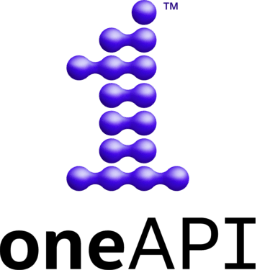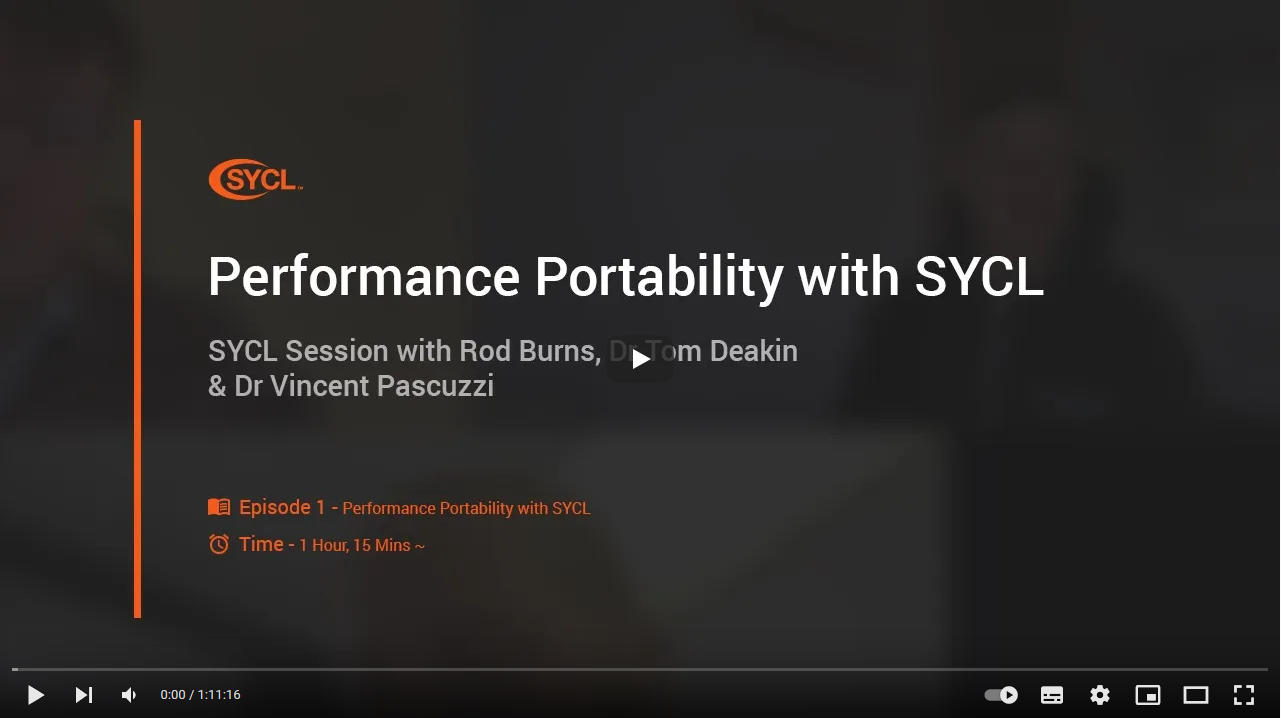The Latest on SYCL™ in Cambridge at IWOCL & SYCLcon
As I return on the train from Cambridge to Edinburgh, I reflect on the first physical IWOCL & SYCLcon in four years and what jumps out at me was the transformation of content since the last physical event in Boston. What I mean by this is that I count roughly 24 SYCL™ presentations and posters, which is a significant increase on the approximately 5 SYCL talks and posters in Boston. The range of content is also unique to this conference, with presentations and posters covering complex science applications alongside in-depth presentations covering potential new features for SYCL and panels consisting of key members of the SYCL Working Group.
The week began for me at the SYCL Practitioners Hackathon organised by Miren at the University of Cambridge. We were lucky enough to be hosted in the Applied Mathematics building which is not only architecturally interesting (I think it would make a good set for a scene in a Star Wars movie or series) but is also home to Stephen Hawking’s office which has been left as it was when he sadly passed away. It’s quite something to think about the bright minds and work that has happened inside the walls of the building.
I helped to organise some aspects of the hackathon, setting up some themes for the participants to work on. We settled on looking at the HeCBench project, a benchmark project that includes implementations across CUDA®, HIP and SYCL. The themes focused on examining some of the benchmarks that exhibited unusual performance results, and those that required updates to the new SYCL 2020 features.
 During the day we all had a lot of fun as well as learning new things from others and the experiences during the day. One of the most exciting aspects of the day was the access to interesting hardware. This was the first hackathon to let SYCL developers access the latest Intel® PVC GPU as well as the Cambridge CSD3 cluster. Attendees were able to run their code on both Intel and Nvidia® hardware using SYCL. Everyone found this to be straightforward with expected results from the benchmarks. This is a great illustration of the portability of SYCL.
During the day we all had a lot of fun as well as learning new things from others and the experiences during the day. One of the most exciting aspects of the day was the access to interesting hardware. This was the first hackathon to let SYCL developers access the latest Intel® PVC GPU as well as the Cambridge CSD3 cluster. Attendees were able to run their code on both Intel and Nvidia® hardware using SYCL. Everyone found this to be straightforward with expected results from the benchmarks. This is a great illustration of the portability of SYCL.
On the second day of the week, I was coordinating a new tutorial covering advanced SYCL topics. As usual, I was joined by a team far more knowledgeable than myself consisting of Hugh Delaney, Aksel Alpay, Ronan Keryell and (remotely) Igor Vorobtsov. This was the first time we have tried to run a tutorial with more advanced topics, as opposed to the Introduction to SYCL we have done many times before. It was extremely popular with around 30 attendees and was well received, it has really motivated us to repeat this and make it even better.
 Following the tutorial day, IWOCL & SYCLcon has two days of presentations consisting of a mix of papers and technical presentations. It began with the usual “State of the Union” where SYCL Working Group chair Michael Wong talked about what has been going on in the past year or so with SYCL. The conformance suite (CTS) for SYCL 2020 was one of the main topics, where the message is that SYCL is one of the few frameworks that provide a conformance test suite for anyone to use. By becoming an adopter – which can be free – you can access all the resources. It is expected that vendors will soon begin their testing and start the official conformance. Another highlight is the inclusion of SYCL in the popular Compiler Explorer project, a web service used by developers across the globe to help them understand code syntax, compile code using lots of compilers and see the instruction output. The DPC++ compiler is now included, and developers can use this to examine the SPIR and LLVM IR output. This is a great learning tool as well as useful for debugging code, and it certainly made me wonder if we could use this valuable service during SYCL tutorials and training, both online and in person.
Following the tutorial day, IWOCL & SYCLcon has two days of presentations consisting of a mix of papers and technical presentations. It began with the usual “State of the Union” where SYCL Working Group chair Michael Wong talked about what has been going on in the past year or so with SYCL. The conformance suite (CTS) for SYCL 2020 was one of the main topics, where the message is that SYCL is one of the few frameworks that provide a conformance test suite for anyone to use. By becoming an adopter – which can be free – you can access all the resources. It is expected that vendors will soon begin their testing and start the official conformance. Another highlight is the inclusion of SYCL in the popular Compiler Explorer project, a web service used by developers across the globe to help them understand code syntax, compile code using lots of compilers and see the instruction output. The DPC++ compiler is now included, and developers can use this to examine the SPIR and LLVM IR output. This is a great learning tool as well as useful for debugging code, and it certainly made me wonder if we could use this valuable service during SYCL tutorials and training, both online and in person.

Following this, I was lucky enough to see all the presentations and I’ll call out a couple of my key observations from the conference.
There were multiple presentations on the experiences of migrating code from CUDA to SYCL. This is an important topic for many developers who are currently working with a code base that is implemented using CUDA, preventing them from running their code on hardware that isn’t made by Nvidia. Whilst there were some comments on edge cases where investigation was needed to resolve code or performance issues, overall, all developers reported the experience was not difficult and brought them very acceptable performance results when compared to native CUDA. By making this migration these organisations have been able to bring their code to new hardware targets, delivering greater levels of choice and freedom.
One of the success stories covered in the past year or so is the GROMACS project using SYCL to widen their target architectures. Andrey, the lead developer of the SYCL part of GROMACS, gave an update on the performance they have been seeing. Whilst there are still some further optimizations to do, the results so far are promising. The adoption of SYCL by such a crucial science project demonstrates the strength of support that SYCL has from the community.
The presentations on new SYCL extensions give us a glimpse of the new SYCL features we are likely to see in SYCL NEXT, the upcoming version of the standard. My colleague Ewan presented the work we have been doing in cooperation with Intel to implement SYCL Graph. This feature is published for everyone to review and comment on and is designed to bring runtime performance benefits. The prototype implementation is already available.
 The last thing to mention is the prize winners, and I am proud to be able to say that my colleague Victor Perez (representing a team effort) won the best paper prize. The paper and our team’s work on kernel fusion has the potential to bring impressive performance benefits, in particular where an application is using lots of smaller kernels. Take a look at the paper to find out more. The other well-deserved winner was Andrey Aleeksenko with his presentation on GROMACS.
The last thing to mention is the prize winners, and I am proud to be able to say that my colleague Victor Perez (representing a team effort) won the best paper prize. The paper and our team’s work on kernel fusion has the potential to bring impressive performance benefits, in particular where an application is using lots of smaller kernels. Take a look at the paper to find out more. The other well-deserved winner was Andrey Aleeksenko with his presentation on GROMACS.
 The conference reminded me how important it is to bring the community together in person and how effective this is in sharing knowledge and bringing about discussions on the direction we should be going. The week flowed from the hands-on coding at the hackathon to the formal learning at the tutorial, and finally the presentations and panels in the conference program. I am excited to be able to look forward to the next IWOCL & SYCLcon in North America (location to be announced) and if you want to be the first to know about what will be happening next year sign up for the IWOCL & SYCLcon mailing list or keep an eye on the Khronos website for news.
The conference reminded me how important it is to bring the community together in person and how effective this is in sharing knowledge and bringing about discussions on the direction we should be going. The week flowed from the hands-on coding at the hackathon to the formal learning at the tutorial, and finally the presentations and panels in the conference program. I am excited to be able to look forward to the next IWOCL & SYCLcon in North America (location to be announced) and if you want to be the first to know about what will be happening next year sign up for the IWOCL & SYCLcon mailing list or keep an eye on the Khronos website for news.


